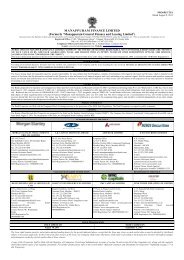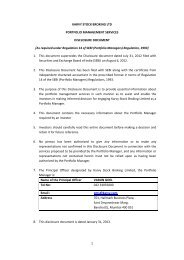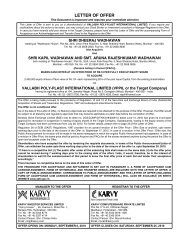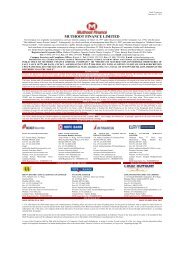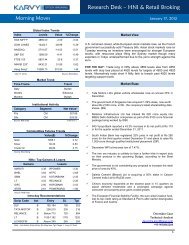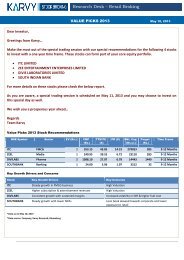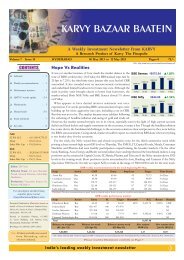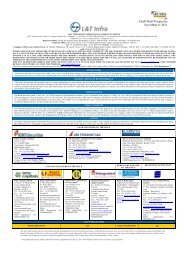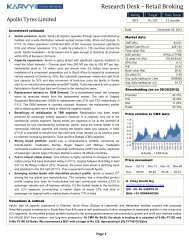APR Constructions Limited - Saffron Capital
APR Constructions Limited - Saffron Capital
APR Constructions Limited - Saffron Capital
You also want an ePaper? Increase the reach of your titles
YUMPU automatically turns print PDFs into web optimized ePapers that Google loves.
Operations and Maintenance (O&M) Contracts<br />
Typically an operations and maintenance contract is issued for operating and maintaining facilities. This could be in<br />
sectors such as water, highways, buildings and power. The contract specifies routine maintenance activities to be<br />
undertaken at a predetermined frequency as well as break-down maintenance during the contract period. While the<br />
contractor is paid for the routine maintenance based on the quoted rates which are largely a function of manpower,<br />
consumables and maintenance equipment to be deployed at the site, any breakdown maintenance is paid for on a costplus<br />
basis.<br />
Front End Engineering and Design (FEED) Contracts<br />
Ordinarily, FEED work is carried out as a part of a consultancy assignment where the consultant provides FEED data<br />
to the project owner to enable it to take a decision on making a tender for construction. In addition to this, the FEED<br />
is also a prerequisite to enable a contractor to bid for EPC/turnkey projects. A FEED project can be an independent<br />
consultancy project or a part of an EPC/turnkey contract.<br />
Price Preference<br />
In tenders for the projects funded by multilateral agencies such as the World Bank and the Asian Development Bank,<br />
where there is international competitive bidding, generally there is a clause giving a price preference of 7.5% for<br />
domestic Indian bidders. In this case, if the bid by the domestic Indian contractor is 7.5% higher than the lowest<br />
international bid, then the employer has to award the project to the domestic bidder. This would be subject to certain<br />
conditions specific to the project. In case the domestic bidder is in a joint venture with an international bidder, then<br />
the domestic bidder would need to own 51% or more in the joint venture in order to qualify for the preferential<br />
treatment.<br />
Purchase Preference<br />
In government tenders for projects normally less than Rs. 100 crores, there is a purchase preference clause wherein a<br />
tender submitted by a Public Sector Undertaking (“PSU”) will entail 10% price preference over other bidders. In this<br />
case, if the bid by the PSU is 10% higher than the lowest bidder, the employer reserves the right to award the project<br />
to the PSU.<br />
IRRIGATION INDUSTRY - OVERVIEW:<br />
Inland Water resources of the country are classified as rivers and canals; reservoirs; tanks & ponds; beels, oxbow<br />
lakes, derelict water; and brackish water. Other than rivers and canals, total water bodies cover all area of about 7<br />
M.Ha. Of the rivers and canals, Uttar Pradesh occupies the First place with the total length of rivers and canals as 31.2<br />
thousand km, which is about 17 percent of the total length of rivers and canals in the country. Other states following<br />
Uttar Pradesh are Jammu & Kashmir and Madhya Pradesh. Among the remaining forms of the inland water resources,<br />
tanks and ponds have maximum area (2.9 M.Ha.) followed by reservoirs (2.1 M.Ha.).<br />
Most of the area under tanks and ponds lies in Southern States of Andhra Pradesh, Karnataka and Tamil Nadu. These<br />
states along with West Bengal, Rajasthan and Uttar Pradesh, account for 62 percent of total area under tanks and<br />
ponds in the country. As far as reservoirs are concerned, major states like Andhra Pradesh, Gujarat, Karnataka,<br />
Madhya Pradesh, Maharashtra, Orissa, Rajasman and Uttar Pradesh account for larger portion of area under<br />
reservoirs. More than 77 percent of area under beels, oxbow, lakes and derelict water lies in the states of Orissa, Uttar<br />
Pradesh and Assam. Orissa ranks first as regards the total area of brackish water and is followed by Gujarat, Kerala<br />
and West Bengal. The total area of inland water resources is, thus, unevenly distributed over the country with five<br />
states namely Orissa, Andhra Pradesh, Gujarat, Karnataka and West Bengal accounting for more than half of the<br />
country's inland water bodies. (Source: www.wrmin.nic.in)<br />
The schemes for irrigation development are conceived, planned and implemented by the respective State<br />
Governments as per their own priorities as Water being a State subject. Government of India encourages the State<br />
Governments to create additional irrigation potential through early completion of the ongoing major and medium<br />
irrigation projects and taking up surface minor irrigation schemes in special category States, tribal and drought prone<br />
79





